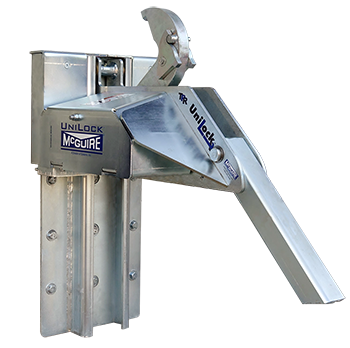Loading dock safety is paramount in today’s warehouse atmosphere. Properly restraining the trailer to the building ensures the truck driver cannot depart while the fork lift driver is in the process of loading or unloading product. Restraints also prevent “trailer creep” caused when a trailer is dropped and left on jacks/landing gear. Fork lift momentum can push the trailer forward if not properly chalked and separate the dock leveler lip from the trailer, or worse, can cause the landing gear to collapse, damaging product and injuring people. More and more companies are turning to truck restraints for loading dock safety.
The TPR UniLock™ is the only trailer-postioned vehicle restraint that can automatically remove “RIG Wedge” pressure. RIG Wedge is caused when the trailer is pushed forward during loading/unloading, and the trailer’s Rear Impact Guard (RIG) applies so much pressure to the restraint’s hook that the truck driver must reverse the trailer in order to release the restraint. The UniLock has an advanced cam design that first rotates the hook away from the RIG to remove the pressure, and then rotates down to a stored position.
This essential piece of loading dock equipment in Florida also has an internal safety mechanism that locks the restraint’s hook in place when pressure is applied, maintaining a secure engagement. This makes it universally effective on any obstructed Rear Impact Guard (RIG), including intermodal trailers with cover plates that prevent the restraint’s hook from latching on top of the RIG.
The UniLock is designed to withstand a pulling force in excess of 32,000 lbs, and has a service range of 4” to 10” horizontally from the face of the dock bumpers and 9” to 30” vertically above drive approach. The integral motor, gear and brake assembly is specifically designed for the UniLock. The UniLock vehicle restraint is highly adaptable to new or existing loading docks.


